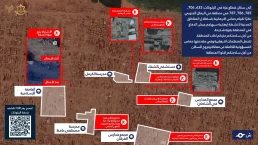The scenes of mass displacement on Wednesday were like a slow-moving human flood flowing through destroyed streets.
By Rasha Abou Jalal, Drop Site
On Wednesday, the Israeli military warned it would attack parts of Gaza City “with great force” and issued new displacement orders targeting several areas in the central and western neighborhoods of the city. Thousands of displaced families in Gaza City began fleeing their shelters in the evening in a state of panic and chaos.
The displacement orders came several hours after Israel committed yet another horrific massacre, bombing five homes in Jabaliya, killing more than 50 Palestinains, including 22 children and 18 women. Israel is on a rampage of bombardment across Gaza—at least 77 killed on Wednesday, over 100 today. On Tuesday, Israel bombed two hospitals in one day, while the third month of a total blockade has left everyone in Gaza hungry and thirsty. Hundreds of thousands of people, many of them children, are facing starvation.

According to a map posted online by the Israeli military, the areas targeted with displacement orders are home to at least eight schools, some run by UNRWA—including the Al-Shati school complex, Al-Karmel School, Mustafa Hafez School, the Al-Furqan school complex, and Islamic University—that serve as shelters for hundreds of thousands of Palestinians already displaced from northern and eastern parts of the enclave.
The orders also include the area where al-Shifa hospital—the largest medical complex in the Gaza Strip—is located. Hundreds of wounded and sick patients are getting treatment and seeking shelter in the hospital.
The scenes of mass displacement on Wednesday were like a slow-moving human flood flowing through destroyed streets. The roar of warplanes combined with the buzzing drones overhead. Men carried what little belongings they could: torn sleeping mats, dusty blankets, and tattered bags. Women walked behind them, carrying or followed by children. Some of the children were walking barefoot, and others dragged their school bags filled with clothes and a few bottles of water. Families headed north, toward the neighborhoods of Al-Nasr and Sheikh Radwan, which were already densely packed and struggling to accommodate people displaced from other areas.
On the side of a road in the al-Nasr neighborhood, 42-year-old Islam Obeid sat with her five children under an old sheet of cloth, trying to find some shelter.
“This is the fourteenth time we have fled from under bombardment since the war began in October 2023,” Obeid told Drop Site. “There is no safe place left in Gaza. Where should we go? Even the streets are closing in on us.”
Her family was first forced to flee from the Al-Zaytoun neighborhood in eastern Gaza City, where they lived before the war. Since then, they have been moving between schools and displacement camps, each time chased by displacement orders and the sounds of falling bombs.
Her 12-year-old son, Mahmoud, stood barefoot beside her, carrying his little sister on his shoulders. “Before the war, I used to go to school,” he said. “Today, I carry my sister and look for a tent with her. We are tired.” He looked at his mother and continued: “I want to live in a house that protects us. I don’t want more displacement, running, and homelessness.”
A nearby explosion interrupted their conversation, prompting the mother to clutch her children in fear. “We are not numbers. We are mothers, sons, and souls being killed every day,” Obeid said. “Every time we displace, we say this is the last time. But it seems displacement is our eternal fate.”
Fleeing a Hospital on Stretchers
At al-Shifa hospital complex, crowds gathered at the main gates to help evacuate their wounded relatives, despite an announcement by the hospital director Mohammad Abu Salmiya that he had not received a direct displacement order from the Israeli army. People streamed out carrying their injured family members on stretchers alongside portable oxygen cylinders.
Mahmoud Deeb, 34, was dragging his wounded brother Ibrahim, 35, on a hospital bed, guiding the rickety wheels over the broken pavement. “I couldn’t carry him,” Deeb told Drop Site, panting with exhaustion and tears glistening in his eyes. “His injuries are severe in the abdomen and legs, his body wrapped in gauze from head to toe. The bed itself became a means of survival. Either we flee with it, or we die together.”
Ibrahim was injured by shrapnel in an airstrike that targeted their home in the Tel Al-Hawa neighborhood a week ago. He trembled in pain and was barely able to speak. “I feel like a living corpse. I thought the hospital was a safe place, and now I’m fleeing from it,” he said.
This is Gaza: a man pulling his wounded brother over the asphalt, not knowing where to go, but refusing to leave him alone to face death.
My Home Becomes a Shelter
While I was immersed in writing this story inside the house in Gaza City I had rented, after my own home was destroyed at an earlier stage of the war, I heard people at the front door. It was my sister Hiba and her family of six: they had come to stay with us, after fleeing their home in the al-Rimal neighborhood.
“I had to displace this time, because I couldn’t find a single reason to stay,” Hiba told me. “Nothing remains to protect us except each other.”
We all gathered in one room, and I brought some bedding for my sister and her family to sleep on. My seven-year-old niece, Layan, asked me, “Auntie, is your house safe from the bombing?” I replied, trying to reassure her, “Yes, it’s very far from the bombing here. You can sleep peacefully.”
I confess: I lied to her. There is no safe place in Gaza at all.
In another room of the house, my sister’s husband sat with my husband, scrolling through his phone in search of any news from Doha, where U.S. President Donald Trump was meeting with the emir of Qatar as part of his visit to the region. Everyone in Gaza has been following his trip with great interest, hoping for any news about a potential ceasefire.
Israel has promised to somehow escalate even more and seize all of Gaza after Trump returns to the U.S. Is this the beginning of that offensive? On Tuesday, Prime Minister Benjamin Netanyahu said Israeli forces were days away from the promised escalation and would enter Gaza “with great strength to complete the mission,” vowing there was “no way” he would halt the attack.
My sister’s husband was visibly exhausted. “Trump promised to end this war but didn’t keep his promise,” he said. “With every displacement, we become refugees in our relatives’ homes. I don’t know how long this situation will continue.”
“The war has turned our homes into suitcases,” he added. “We hang them on our backs and search for a corner to live another day.”
I had to turn back to writing this article about yet another mass displacement in Gaza that now includes my extended family displaced to my living room.
Recent Posts
The “President Of Peace” Prepares For War
December 23, 2025
Take Action Now The Donroe Doctrine Hits HomeBy William D. Hartung, Tom Dispatch Earlier this month, the Trump administration released its new…
“Who Are They Protecting?”: Rep. Ro Khanna Urges Contempt Charges Over AG Bondi’s Epstein Redactions
December 22, 2025
Take Action Now “The House can act unilaterally on contempt, and this will be introduced by Thomas Massie. What the resolution will say is that…
Dems Demand Answers as Trump Photo Disappears From DOJ Online Epstein Files
December 21, 2025
Take Action Now “What else is being covered up?”By Brett Wilkins, Common Dreams Congressional Democrats on Saturday pressed US Attorney General…
Elon Musk Is Vowing Utopia Driven by AI and Robotics. Bernie Sanders Has a Few Questions
December 20, 2025
Take Action Now “I look forward to hearing about how you and your other oligarch friends are going to provide working people with a magnificent life…




